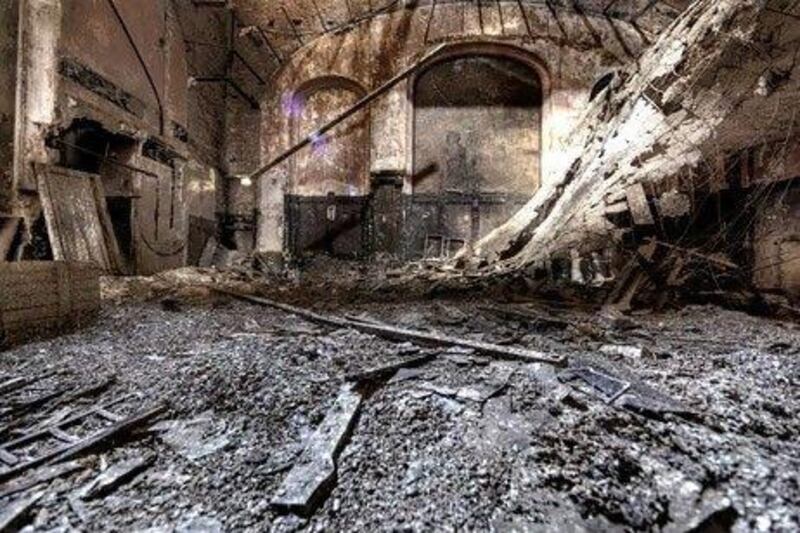BERLIN // The grand, stuccoed ceiling had caved in and pigeons flapped around a silent hall that had once echoed with the footsteps of people dancing the Charleston and the excited chatter of diners.
The chance discovery of an abandoned cabaret theatre in Berlin was revealed last month, awakening nostalgic memories of the city's cultural heyday during the Roaring Twenties - before the fun came to an end with Nazism, the Second World War and decades of Cold War division.
"It's an incredible place. I fell in love straight away," said Dirk Moritz, a property developer who found it in a derelict building in the former communist east of the city. "Everyone is interested in things that have been forgotten for more than 80 years because they're a piece of history. And I think we're all curious to see what Berlin was like in the 1920s."
The find has struck a chord with Berliners at a time when its reputation as a carefree party town is again at risk, this time from creeping gentrification. Developers and well-heeled newcomers are moving in, driving up rents and pushing out theclubs and bars that made Berlin's nightlife famous in the two decades since the fall of the Berlin Wall.
Mr Moritz said he was taking his daughter to a swimming pool on a rainy November evening in 2008 when he saw a run-down building and felt an urge to look inside.
He pushed open a steel gate leading to a courtyard filled with junk and old cars. "I saw the dark outlines of the building at the rear of the courtyard and there was something about it," he said. "I had to see it."
A few days later, he persuaded the janitor to let him into the house for a few minutes.
"He locked the door behind me." said Mr Moritz. "I only had a small torch and walked into this building with collapsed ceilings, tonnes of rubbish and hundreds of pigeons. The smell from them was so bad you needed an oxygen mask after 10 minutes.
"I climbed up staircases in the dark, not knowing if they were going to cave in, and then reached the theatre hall on the second floor."
The 300 square-metre theatre - with its grand stage, remnants of stucco on the walls and frescoes visible behind peeling wallpaper - gave a glimpse of the wild, fleeting era of freedom and abandon.
By torchlight it was impossible to see the full size of the place. Mr Moritz, who founded and manages a Berlin-based property firm, Moritz Gruppe, set about researching its history and spent years negotiating with the owners, who had inherited it. They live in the Czech Republic and had never even seen it.
Finally, last year, the company gained access to the building and cleared out 30 tonnes of rubbish
As there were no official records on the theatre, the city archive appealed for information from the public. It turned out that the house had been purpose-built as a restaurant and theatre in 1905, with grand rooms to hire for private events. It had a kitchen on the ground floor and a special lift to deliver food and drinks.
Originally called Fritz Schmidt's Restaurant and Festival Halls, in 1919 it became the Kolibri Festival Rooms and Cabaret. It shut down at some point in the 1930s. After the war, the ground floor was used as a rubbish dump and part of it became a metalworking shop.
The building is in the Mitte district of Berlin. Mr Moritz calculated that in the few streets around the theatre alone, there used to be 136 entertainment venues, including bars and restaurants - and that was only a small slice of Berlin's nightlife in the 1920s.
"It makes you wonder who actually did any work at the time," he said.
City regulations prevent him from returning the building to its original use, so his company plans to turn it into apartments and a venue for exhibitions and meetings as part of a project called Secret Garden.
"As far as possible we'll conserve the existing stucco features but we won't reconstruct everything," he said. "I don't believe it would do the building any good. We'll play with new and old elements."
Very few of the old theatres and ballrooms survived the war and Berlin's division. One that did is a popular dancing venue and restaurant called Clärchen's Ballhaus.
"Young people like the aura of Berlin in the 1920s, but we also get people who used to dance here in the old days," said Mirjam Abele, a spokeswoman for Clärchens. "There is nostalgia for that era."
Berliners are even starting to feel nostalgic for the 1990s, when scores of trendy restaurants, bars and clubs sprouted as the city savoured its new-found freedom after the wall fell. The city's famous club scene has come under threat from residents complaining about the noise and investors bent on converting venues into upmarket apartments.
About 15 clubs face closure and several famous ones have already gone, such as the legendary Knaack club, which closed after almost 60 years because residents in a newly built apartment block said it was too loud.
Mr Moritz, a Berliner born and bred, said the city must to do more to attract investors and business, but he shared concerns about the cultural scene.
"This town has a huge number of attractions which we are destroying by taking legal action against everything and everyone if there's music after 10 o'clock."






